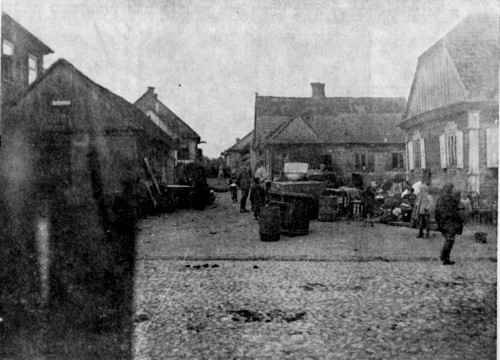 |
|
|
[Page 357]
History of Kamenetz-Litowsk and Its Jewish Settlement[1]
By Levi Sarid (Laybl Goldberg)
Translated by Allen Flusberg
The following figure appeared on p. 375 of the Yiddish article.
|
|
| A Street in Kamenetz |
Translator's Footnote
[Page 400]
by Falek Zolf[2]
Translated by Allen Flusberg
A group of friends and I began to think about establishing a modern school for the Jewish children of Zastavya. At that time only a few middle-class boys were studying in the small number of private Ḥayders [religious schools for children] that were left in Zastavya.
What a modern Yiddish school should consist of and how it should operate—this I had already seen in the Russian city Yaroslavl, beyond Moscow[3], where I wound up as a result of the war [World War I]. I had been exiled there, homeless, together with several hundred other Jewish families from war-torn territories.
I had resolved that I must establish a school for the children of Zastavya. But the question was: where in this burnt-down town could I find a suitable space, the requisite furniture and other items? Where could I get teachers? And where could I get young people who would want to help this enterprise along? The few young people who had survived and remained in Zastavya were about to leave—some to the Land of Israel and others to America. The situation was not a happy one; but I was too taken with the idea of a school to give up so quickly.
I went over to see “the Saperstein brothers”[4]—as they were known in the neighboring town of Kamenetz—with my plan to establish a Yiddish school in the little suburb of Zastavya.
Intelligent young men, the Saperstein brothers were former non-matriculated students who before the war had been preparing themselves to take examinations for an Attestat Zrelosty[5]. They were so enamored with my proposal that their eyes practically lit up with delight. They were captivated by the thought of becoming the pioneers of an all-Yiddish school.
[Page 401]
Right away Asher, the oldest of the four Saperstein brothers, ran off to fetch a bottle of whiskey and a snack—some salted herring. We all drank a l'ḥaim [toast] to the life of the first new school in the suburb of Zastavya.
We got right down to work. First, we rented half a house from a fellow-Jew who had just finished putting up its roof. We hammered a board together and blackened it to use it as a blackboard—reasoning that once we had a blackboard, we would soon have a school, as well. Then we all chipped in to purchase some wooden planks. After planing them down, we used them to construct tables and benches, making sure they were long enough to accommodate a large number of children.
The older boy students helped out, hammering nails wherever needed—and in places where there was no need for them, as well. The girls decorated the classroom with colored paper and hung portraits of Yiddish authors on the walls; they had cut these pictures out of old Yiddish newspapers. Outside the front door we hung a sign on which we had written Die Zastavyer Yiddishe Folks-Shule [The Zastavya Yiddish Public School] in giant block letters.
The parents—and even more so the children—were inspired, especially since we were not asking them to pay any tuition. We also provided all the requisite teaching supplies—to the extent that such items were even available then. All these things were funded by a special subsidy from the American Joint[6]. And in addition to their salaries, the teachers were given a bonus: a provision of food payok [rations] from the Kinder-Kich [Children's Kitchen], which the Polish-American Committee was providing[7].
The school reinvigorated our quiet, darkened little suburb. A new Yiddish song, with an old-new Yiddish melody, resounded throughout the Jewish street and echoed in every Jewish home. The children embraced the school the way a small child clings to its caring mother. They showered us teachers with a great love that warmed our hearts and encouraged us to be strong for the work that lay ahead.
[Page 402]
All the responsibility of keeping the school going lay on my shoulders, since I was the principal; but in addition, I also had to serve as a teacher of Tanach [Bible] and history. I will never forget the day I stood face-to-face with my young neighbors, the children of my little shtetl, to lecture to them for the first time. At the time, this was one of the happiest moments of my life.
(From Falek Zolf's Book, Zichroinos [Memoirs])
Translator's Footnotes
|
|
JewishGen, Inc. makes no representations regarding the accuracy of
the translation. The reader may wish to refer to the original material
for verification.
JewishGen is not responsible for inaccuracies or omissions in the original work and cannot rewrite or edit the text to correct inaccuracies and/or omissions.
Our mission is to produce a translation of the original work and we cannot verify the accuracy of statements or alter facts cited.
 Kamenets, Belarus
Kamenets, Belarus
 Yizkor Book Project
Yizkor Book Project
 JewishGen Home Page
JewishGen Home Page
Copyright © 1999-2026 by JewishGen, Inc.
Updated 22 Jan 2021 by MGH